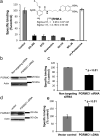Identification of the PGRMC1 protein complex as the putative sigma-2 receptor binding site
- PMID: 21730960
- PMCID: PMC3624020
- DOI: 10.1038/ncomms1386
Identification of the PGRMC1 protein complex as the putative sigma-2 receptor binding site
Abstract
The sigma-2 receptor, whose gene remains to be cloned, has been validated as a biomarker for tumour cell proliferation. Here we report the use of a novel photoaffinity probe, WC-21, to identify the sigma-2 receptor-binding site. WC-21, a sigma-2 ligand containing both a photoactive azide moiety and a fluorescein isothiocyanate group, irreversibly labels sigma-2 receptors in rat liver; the membrane-bound protein was identified as PGRMC1 (progesterone receptor membrane component 1). Immunocytochemistry reveals that both PGRMC1 and SW120, a fluorescent sigma-2 receptor ligand, colocalize with molecular markers of the endoplasmic reticulum and mitochondria in HeLa cells. Overexpression and knockdown of the PGRMC1 protein results in an increase and a decrease in binding of a sigma-2 selective radioligand, respectively. The identification of the putative sigma-2 receptor-binding site as PGRMC1 should stimulate the development of unique imaging agents and cancer therapeutics that target the sigma-2 receptor/PGRMC1 complex.
Figures




References
-
- Hellewell SB, et al. Rat liver and kidney contain high densities of sigma 1 and sigma 2 receptors: characterization by ligand binding and photoaffinity labeling. Eur J Pharmacol. 1994;268:9–18. - PubMed
-
- Matsumoto RR, Liu Y, Lerner M, Howard EW, Brackett DJ. Sigma receptors: potential medications development target for anti-cocaine agents. Eur J Pharmacol. 2003;469:1–12. - PubMed
-
- Takebayashi M, Hayashi T, Su TP. Nerve growth factor-induced neurite sprouting in PC12 cells involves sigma-1 receptors: implications for antidepressants. J Pharmacol Exp Ther. 2002;303:1227–1237. - PubMed
Publication types
MeSH terms
Substances
Associated data
Grants and funding
LinkOut - more resources
Full Text Sources
Other Literature Sources
Molecular Biology Databases
Research Materials

